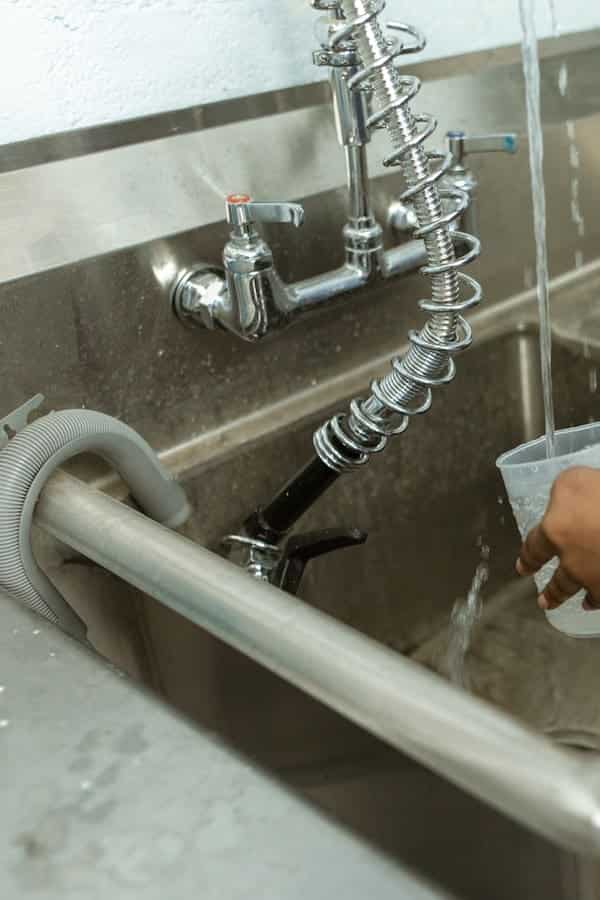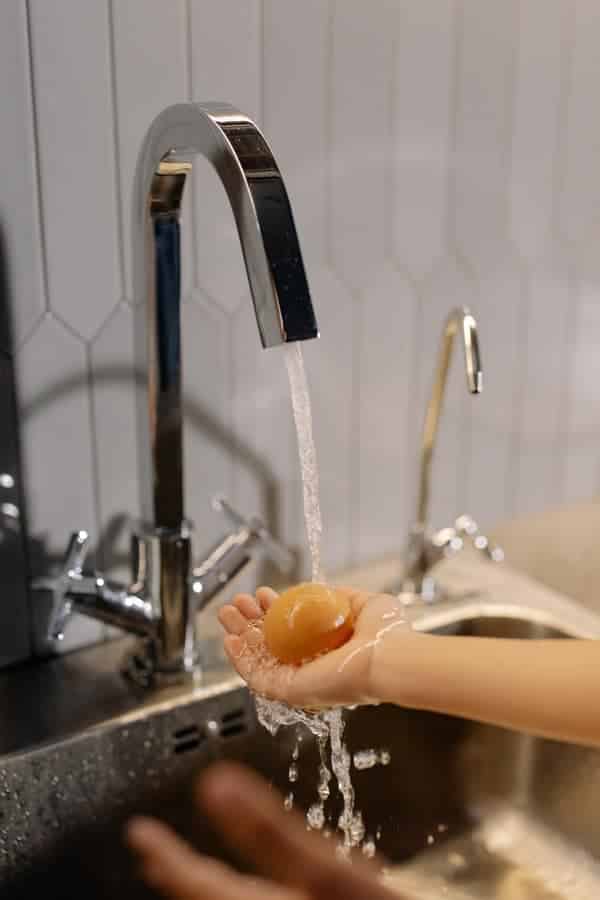Stainless steel sinks are very popular in kitchens due to their long-lasting wear and because they shine, so look great. It’s important that you’re keeping on top of the cleaning and maintenance of your stainless steel sinks in order to preserve corrosion resistance.
You can easily clean your stainless steel sinks by using many different techniques and products. The more you can clean it, the better and thankfully, unlike many other materials used within the kitchen, stainless steel won’t be affected by excessive cleaning.
So, what is the best way to clean your stainless steel sinks and make them sparkle?
- Baking Soda
- Flour
- Vinegar
- Baby Oil
- Cleaning a stainless steel sink properly
- Use a scouring pad
- Use glass cleaner
- How to ensure your sink is in great shape
- What not to do with stainless steel sinks
- General cleaning tips
- Why are stainless steel sinks so popular?
- How to sanitise your stainless steel sink
- Conclusion
There may be affiliate links in this article. You can read more about this in my disclosure.
Baking Soda
Baking Soda has so many purposes for use around the house, and it’s the most common method of cleaning your stainless steel sinks. Mix some baking soda with a small amount of water until it becomes a paste, and then spread it all over your sink.
Baking soda will remove any stains, grease and water deposits which is great. If you’re looking for the paste to fizz and to get rid of additional smells that may have occurred, add some white vinegar.
Leave it to soak for about 10 minutes and then use boiling water to clean up the residue.
Flour
This might sound like a strange method, and one you probably haven’t heard of before, but it can be very effective. Simply add a few tablespoons of all-purpose flour and sprinkle it around your sink before using a soft cloth to rub it in.
This does take a bit more effort, but when you wash it away, your stainless steel will have its shine back.
Vinegar
If you’re struggling with water spots on your stainless steel sink then this can be really annoying when you’re cleaning. Simply grab a sponge, dip it into some white vinegar and scrub it along the water marks that are bothering you.
Thankfully, it doesn’t take a lot of effort to get these stains removed. Afterwards, simply run some water over your sink and use a dry microfiber to buff the area.
If you’ve noticed that there is a bit of rust, you could use some rubbing alcohol which will remove it easily.
Baby Oil
If you’re looking for a sparkle like no other, and one that will really impress your guests in your home, then baby oil is definitely a product you should be considering.
Baby oil will get that shine back in your stainless steel sink.
Add a few drops of baby oil to a paper towel and wipe it over your sink, or you can add a few drops into your sink and wipe it with a microfibre. You may never have realised that your sink could get as sparkly as it’s going to be.
Cleaning a stainless steel sink properly
It’s important for you to know how to clean your stainless steel sink properly and which products you can and can’t use.
Ensure that you’re getting rid of food in the sink and rinse
I’m sure there have been times when you look at your sink at the end of the day and you wish that it would either do it yourself, or you want to put it off until the morning.
If you’re leaving your washing up, then this can cause odours that aren’t appealing. It’s best to remove all food and plates that are within your sink and rinse around.
Use a cloth or kitchen towel to remove any bits in the plughole and wipe around with water to get the loose debris away.
Use a scouring pad
It’s best to use an anti-scratch scouring pad to add some anti-grease cleaner, kitchen cleaner or washing up liquid. It’s important that you’re definitely using an anti-scratch sponge and not wire wool or a hard scouring pad because this can scratch your stainless steel sink.
Work gently by firmly with your sponge and ensure that you’re getting in the corners, and the taps and plug holes. Once you’re done, rinse the residue away with water.
Use glass cleaner
If you’re not a fan of baby oil, you can use a glass cleaner to buff your sink up and to ensure that it is left with a gorgeous sparkle. Spray your taps and sink with glass cleaner and use a kitchen towel to clean – in the same way as you could a window.
You can make your own glass cleaner by mixing white vinegar with lemon essence. You will get a really nice shine by using this method and it only takes approximately 10 minutes to achieve.
How to ensure your sink is in great shape
You might think that cleaning your sink regularly isn’t needed, and so you stick to a once per week cleaning routine. However, this isn’t enough.
Your sink is where all dirty plates and utensils reside before you clean them. This can cause a build up of bacteria and food which can progressively cause smells that you definitely don’t need.
So, how can you ensure that your stainless steel sink is in its best condition?
Every time you use your sink, give it a bit of a rinse.
Use a kitchen cleaner and wipe around your sink daily.
If you are in a hard water area then ensure that you’re giving particular attention every couple of days in order to remove any limescale build up.
Ensure that you’re never using bleach on your stainless steel sink as this can cause a reaction and ultimately stain.
What not to do with stainless steel sinks

Never use abrasive and steel wool pad on your sink and this can lead to scratching and corrosion or rust.
If you leave rags or towels on your sink’s surface then this can cause build up bacteria and will cause the surface to become dull.
Rinse your sink on a regular basis in order to keep the chlorides in your cleansers impacting your steel.
Remove any cast iron or steel cookware from your sinks as this can lead to staining and surface rust.
Leaving any cleaning pads in your sink can cause staining and discoloration, so it’s important to remove these once you’ve finished using them.
Remove and don’t keep sharp utensils in your sink as they can cause scratching.
General cleaning tips
Ensure that you’re drying your sink regularly in order to prevent rust marks and water stains
When you work with cleaners for your sink, wear gloves in order to protect your skin.
Light cleaning your sink every day will keep it in great condition. Ensure that any waste residue is cleaned before it dries.
Avoid mixing any cleaners as some may react to your steel and create dangerous gases.
Solvents shouldn’t be used unless you have a decent amount of ventilation.
Why are stainless steel sinks so popular?
Stainless steel sinks are popular for many reasons. They absorb shock so they give little impact and will provide a cushion for your glasses and plates in order to prevent breakage.
Compliments any house decor. Regardless of the style or theme you have going on around your house, a stainless steel sink will work perfectly and compliment alongside it.
There is a flexibility and strength in stainless steel sinks which means that you can have deep sink bowls.
You won’t have any stains, rust or fading with stainless steel and any dirt can be removed easily.
Stainless steel lasts longer than a lot of other materials that could be considered in a kitchen. If you’re using your sink for heavy duty washing up, then you can be rest assured that there won’t be cracking, nicking or chipping away at the material.
How to sanitise your stainless steel sink

As a disinfectant, the first product you’re going to be thinking of is probably bleach. However, it’s important to avoid this product on any of your stainless steel sinks.
There are a few products that you can use instead:
Hot water: Fill your sink with boiling water from the kettle and let it sit for a few minutes. This is the best way to kill any bacteria and germs that are residing within your sink.
Vinegar: As mentioned quite a lot within this article, white vinegar is used for many things. However, use it with caution as leaving it to soak for too long can cause damage.
Mix ¼ cup of salt with 4 cups of vinegar and soak a cloth in the solution. Layer them on your stainless steel sink’s surface.
Let it sit for approximately 10 minutes and rinse thoroughly.
Conclusion
Stainless steel sinks are one of the best materials you can use as your sink in your kitchen. It is durable and lasts a very long time.
It is also really easy to clean and get the sparkle back if you’ve noticed a dull colouration appear. We hope that we have given you some handy tips that you can use and you continue to keep up your cleaning routine.
Last update on 2024-04-19 / Affiliate links / Images from Amazon Product Advertising API










